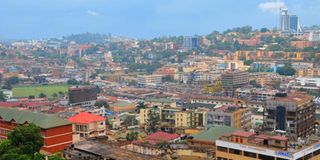Report links unemployment in Kampala to poor planning

A new World Bank report indicates that congestion within Kampala City resulting from poor physical and urban planning has scared away investors. PHOTO BY MICHAEL KAKUMIRIZI
What you need to know:
- In Kampala, top civil servants lived in places like Kololo and Naguru, lower level civil servants lived in flats and in posh upscale places like Kololo while factory workers lived in estates in Naguru, Nakawa and Luzira.
- Mr Patrick Musoke, the KCCA deputy director strategic management and business development, attributed it to the unplanned development of the city which has expanded to Kampala Metropolitan, creating bottlenecks like traffic jams.
KAMPALA. A World Bank report released on Monday has shown that congestion within Kampala City resulting from poor physical and urban planning is one of the factors causing unemployment.
According to the report, poor urban planning has made the city look unattractive to potential investors who would create jobs.
The findings are entailed in a study commissioned by Kampala Capital City Authority in partnership with World Bank under the title, “Enhancing economic development and job creation in greater Kampala”.
The report further sought means of providing practical actions to unlock the city’s economic potential with the aim of finding practical actions to be taken to unlock the city’s economic potential.
The report calls for repositioning of KCCA from being a regulator, to an enabler of the private sector to develop by creating organised and efficient systems which will facilitate smooth running of factories and hence job creation.
While explaining the findings of the report, Ms Kaia Miller, a consultant in strategy for emerging markets, said the current setup of Kampala City is based on the colonial plan.
She noted that the city needs reorganisation to accommodate the expanded population by zoning the city to create economic production zones that create jobs to boost economic production.
During the colonial times and shortly after independence, housing planning in the city was carefully carried out to cater for the different categories of people according to their incomes.
In Kampala, top civil servants lived in places like Kololo and Naguru, lower level civil servants lived in flats and in posh upscale places like Kololo while factory workers lived in estates in Naguru, Nakawa and Luzira.
With such organisation, providing amenities like water, power, and telephone lines was easier. Security was also easier to maintain, and the living quarters were more hygienic.
With the breakdown in planning and control, heightened by the chaos that attended Idi Amin’s rise to power, anyone would then build anywhere.
This worsened as an increasing number of people poured into the city in search of better paying jobs but ended up unemployed. These people set up ‘houses’ anywhere, without planning. Successive governments did little or nothing about it.
“If I may ask, where is the innovation, research and development hub for Kampala City? You should have an area which is known for production of specific goods and services. This is what attracts investors,” Ms Kaia said.
She explained that such areas usually have incentives such as cheap electricity, well serviced infrastructure like roads, water and organised transport systems that do not cause delays for the investor when evacuating goods from the factories to the market.
Mr Patrick Musoke, the KCCA deputy director strategic management and business development, attributed it to the unplanned development of the city which has expanded to Kampala Metropolitan, creating bottlenecks like traffic jams.




